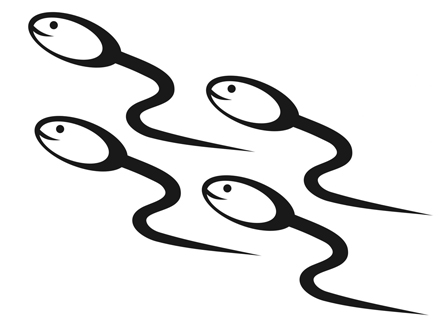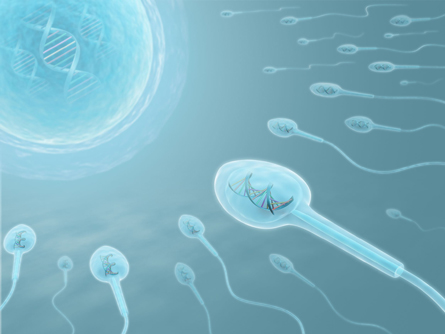Module 3
1. Module 3
1.12. Page 2
Module 3—The Male and Female Reproductive Systems
 Explore
Explore

© Jan Vancura/123RF Limited
This lesson is divided into two parts: the study of spermatogenesis and of oogenesis.
spermatogenesis: the process of spermatogonia dividing and differentiating to form mature male gametes (sperm)
oogenesis: the process of oogonia dividing and differentiating to form female gametes (eggs)
Spermatogenesis
While women are born with all the eggs they will ever have during their lifetime, men produce sperm on a continuous basis from the onset of puberty onward. Therefore, a man’s sperm development can be affected by what he does daily. Choices a man makes regarding smoking, stress management, nutrition, exercise, and drug and alcohol use contribute to the production and quality of his sperm. Regardless of the choices he makes, the quality of a man’s sperm begins to slowly decline at approximately age 25.
Gametogenesis is the formation of sex cells, or gametes, during meiosis. Human male and female gamete formation follows the same general meiotic process; however, there are significant differences, such as the number of gametes produced and how the cytoplasm is divided. Spermatogenesis is the term used to describe the process unique to sperm gamete production. Mature male gametes, commonly called sperm, are scientifically referred to as spermatozoa. During the early stages of development, germ cells and immature gametes are supported, nurtured, and protected by specialized supporting somatic cells, the Sertoli cell and interstitial cells.
Sertoli cells are found in the testes, within the seminiferous tubules, and are sometimes referred to as nurse cells. They nurture the developing sperm cells by providing secretory and structural support. By producing the hormone inhibin, Sertoli cells perform the secretory function. Inhibin targets the anterior pituitary and hypothalamus to inhibit the production of follicle stimulating hormone (FSH). The Sertoli cells also give structural support by acting as a barrier to protect the sperm during their development. The body considers sperm cells to be foreign to the body. If not protected by the Sertoli cells, the body’s immune system would destroy them.
gametogenesis: the process of creating gametes from somatic germ cells; includes meiosis
spermatozoa: mature sperm stored in the epididymis
somatic cell: a normal diploid body cell; a cell not involved in fertilization
interstitial cells: tightly packed testosterone-secreting cells that surround the seminiferous tubules in the testes
inhibin: a hormone produced by Sertoli cells during spermatogenesis that inhibits production of FSH, preventing excessive sperm production
Interstitial cells are found in the testes but are not found in the seminiferous tubules. While they are only indirectly linked to sperm production, they do secrete testosterone, which targets the entire male body and stimulates the development of the male reproductive system, the secondary male sex characteristics, and spermatogenesis.
 Read
Read
Reread section “The Testes” on pages 479 and 480 of the textbook. Focus on information about the supporting structures of the gametes.
To gain further understanding, do an Internet search using the search terms “Sertoli cells” and “interstitial cells.”

© Kiyoshi Takahase Segundo/123RF Limited
 Watch and Listen
Watch and Listen
Watch the following segments of “The Human Male Reproductive System: Perpetuating the Species” to further your understanding of how the structural support tissue helps develop the male gametes. Take notes as you watch, and save them in your course folder.
- “Semen and Ejaculation”
- “Spermatogenesis”
- “Bio Bit: Semen Components”
You may be required to enter a username and password to access the video. Contact your teacher for this information.
Oogenesis
In females, the germ cells or gametes are the egg cells. The process of developing mature egg cells is called oogenesis. Follicles are the structural supporting cells that surround and develop the egg.
oogonia: diploid cells in the ovary that will undergo meiosis
oocytes: cells that are undergoing meiosis in the ovary
primary oocytes: cells in the first meiotic division of oogenesis
Egg cells begin as oogonia and then develop into primary oocytes. About 700 primary oocytes are formed in the ovaries during fetal development. The primary oocytes stay dormant in the female body until the beginning of puberty. At the onset of puberty, some of the primary oocytes will further develop into functioning egg cells, generally at a rate of about one per month. While in the ovary, each primary oocyte is surrounded by follicles. Together the primary oocyte and the follicle cells surrounding it are referred to as the primary follicle.
Like Sertoli cells, the follicles perform a secretory and structural support function for the developing gamete. The follicles give secretory support by releasing estrogen and some progesterone. The follicles give structural support by fully surrounding the egg, thereby helping to nourish and protect the primary oocyte. When chemically stimulated to do so, the primary follicle helps develop the primary oocyte into a secondary oocyte and then into a fully functioning mature egg. Ovulation takes place when the fully matured egg is expelled from the ovary.
The support of the follicles and Sertoli cells helps ensure properly formed gametes, which can then combine during fertilization to form an embryo, thus continuing the species.
 Read
Read
Reread the section “The Ovaries” on page 482 of the textbook to review the process of oogenesis. This section of the textbook does not present much information about the role of the follicles. To gain further information, do an Internet search using the search term “follicles” or “follicle cell.”
 Watch and Listen
Watch and Listen
Watch the segment called “Oogenesis” in the video “The Human Female Reproductive System: A Creation of Exquisite Synchrony” to further your understanding of oogenesis and the role of the follicles. Take notes as you watch this video and save them in your course folder.